The iPhone 4 Redux: Analyzing Apple's iOS 4.0.1 Signal Fix & Antenna Issue
by Brian Klug & Anand Lal Shimpi on July 15, 2010 12:28 PM EST- Posted in
- Smartphones
- Apple
- iOS 4
- iPhone 4
- Mobile
Better at the Low End, Mixed Feelings Everywhere Else
Brian came up with the plan to enable the numerical signal strength visualization and executed on it very well in our original iPhone 4 review. Since then there’s been a disturbing amount of debate as to whether or not this actually amounts to a problem with the phone.
Part of the confusion stems from the fact that doing this sort of antenna testing in a real world scenario is time intensive. As Brian mentioned on the previous page, for today’s article both of us were driving around our respective cities, stopping at various locations, measuring signal strength and comparing it to bar mappings in order to produce the charts you saw on the other page.
There’s no denying that Apple has played a significant role in why there continues to be debate about the iPhone 4 antenna. By simply addressing the pre-4.0.1 bars not being a good representation of signal strength and ignoring the fact that the iPhone 4 does lose more signal strength than competing phones depending on how you hold it, Apple manages to convince its faithful that there’s nothing wrong while driving its critics to demand a recall.
My mother always taught me that honesty is the best policy and presumably I’m not the only one in the world who was privy to this information. Had Apple come clean with both of these facts (the bar mapping and the signal attenuation issue) early on we’d be in a far more clear cut world today.
We have consistently argued that the 4’s antenna is a design choice by Apple. As we’ve seen in our testing there are situations where the iPhone 4’s antenna makes things better (e.g. holding onto calls with very low signal strength) and other situations where the design makes them worse (e.g. holding it wrong in situations with low signal strength). I wanted to describe the inconsistency in greater detail so I went out with an iPhone 3GS and 4 and documented my experiences.
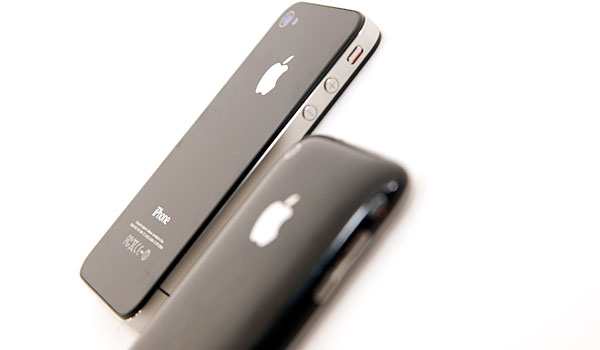
In practice I found three things that were true about the iPhone 4’s antenna behavior compared to the 3GS.
Reception in average conditions is sometimes significantly better on the iPhone 4 than on the 3GS. Take a look at the image capture below. In the same exact location we have better reception on the 4 than the 3GS. Granted this could be due to a number of variables outside of the phone’s antenna itself, but it happened enough times that it’s worth reporting. This is the positive to Apple’s external antenna design - you can and do get better reception. Unfortunately the tradeoff is the scenario I just described before this.
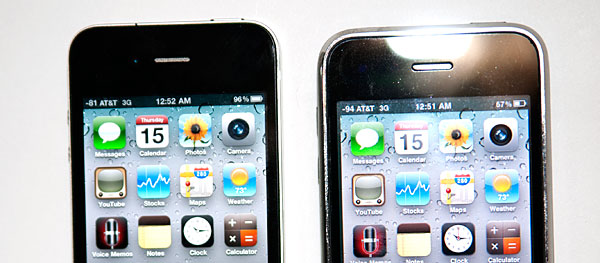
iPhone 4 (left) at -81 dBm vs. iPhone 3GS (right) at -94 dBm
Signal strength is sometimes the same as or worse than the iPhone 3GS. This is really where the problem comes into play. In the shot below I have the 4 and 3GS sitting next to one another and they are displaying roughly the same signal strength. We’ve already proven that holding the iPhone 4 attenuates its signal more than the 3GS, which results in the frustration we’ve seen expressed by many at this point. In situations where the 4 has the same signal as the 3GS, holding the phone is going to drop it to levels significantly worse than the 3GS. If you’re in an area with low signal strength to begin with, holding the phone is going to bring you down to dangerously low levels.
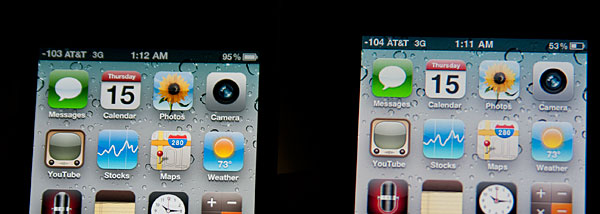
iPhone 4 (left) at -103 dBm vs. iPhone 3GS (right) at -104 dBm
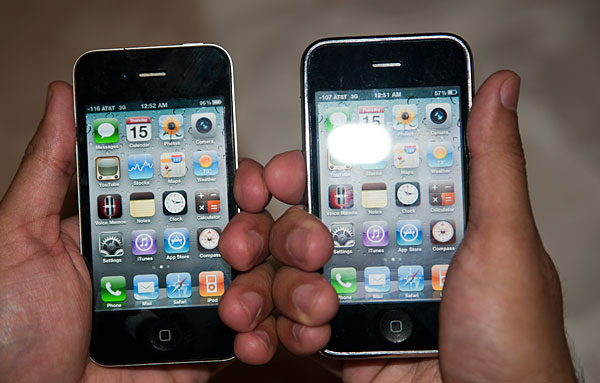
iPhone 4 being held tightly (left) at -115 dBm vs. iPhone 3GS being held tightly (right) at -107 dBm
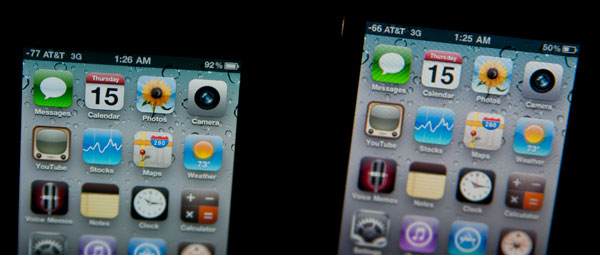
iPhone 4 (left) at -77 dBm vs. iPhone 3GS (right) at -66 dBm
The iPhone 4 is better at holding onto calls and data at very low signal levels. We’ve mentioned this one before but it’s worth reiterating. The new antenna does let me make calls and transmit data at very low signal strength. With the iOS 4.0.1 update I was able to make a call at -115dB on the 3GS, however the call did drop within a minute of starting it. By comparison I was able to have a much longer conversation without dropping the call at -120dB on the 4. By no means is this a scientific comparison, but anecdotally both Brian and I feel that the low signal strength performance of the iPhone 4 is better than the 3GS.

A call at -120 dBm on the iPhone 4
If you’re keeping tabs you’ll note that this is what is traditionally referred to as a trade off. Apple opted for good performance in low signal situations (and style of course) over maintaining consistently better or unchanged radio performance compared to the 3GS. I would personally consider this to be an unnecessarily risky design choice, particularly for a smartphone vendor. Note that it's nearly impossible to separate out the antenna from the rest of the iPhone 4 platform to determine exactly what is responsible for the phone's signal sensitivity in various situations. All we ultimately know is how physically interacting with the antenna impacts reported signal strength.
I can’t stress enough that this issue impacts all users. The variability is in how strong of a signal you have to begin with. That’s the absolute only reason there’s debate in these discussions from phone to phone. At my desk I don’t get great reception on AT&T. With the iPhone 4 I’m usually at -96dBm. If I keep a tight grip on the phone or if I’m holding it to send text messages I can sometimes lose all signal entirely. This is a combination of poor reception at my house and the fact that the 4 loses more of its signal than other phones when held certain ways.
Brian on the other hand has much better reception at his home. To him, the signal strength drops but it does not drop enough for this to be a problem. I consider myself to be on the border. If I’m mindful of how I’m holding the phone it’s not an issue, and even most of the time if I’m not paying attention to it it’s not an issue. However there are definitely times when it does become a problem. I wouldn’t consider it to be the majority of the time or even more than 10% of the time, but it happens enough for me to have to think about it. Ultimately this is why I consider Apple’s design here to be unnecessarily risky. Introducing a change with stylistic and technical benefits where the downside is limited but potentially very noticeable is just ballsy.
Luckily for Apple, there are things that can be done about it.










146 Comments
View All Comments
bplewis24 - Friday, July 16, 2010 - link
Because it does not. Look up any number of videos on the subject: http://www.youtube.com/watch?v=F6oflC4qo8M&pla...eliotw - Friday, July 16, 2010 - link
Anand's results shown in this article seem to show otherwise. In the video you linked it's not too surprising that data rates would slow down as the iPhone adjusted for the sudden attenuation in signal strength. That "test" could have been better if they let the phone stabilize before attempting to load data. I don't question that signal attenuation is happening but based on the results here is seems like overall it's as good or better than the 3GS.ajb - Saturday, July 17, 2010 - link
It deserves an urgent fix because although it might be better in some situations (when it's on a desk and not being held or only lightly held with two fingers on the center edges of the phone) in many situations with a weak signal present just holding the phone normally can attenuate the signal enough to drop the call. Based on my own experience, you don't need anywhere near a "death grip" to drop a call in such situations. That's a real problem and Apple is only paying it lip service. A free bumper, even though it would likely solve the problem, is far short of a fix for a phone that has been marketed as the thinest coolest phone of all smartphones. Many people, me included, don't want to have to put a bumper on the phone. I bought an Invisishield to protect the phone ($30 for front and back, plus $13 for Best Buy to install) for the specific reason of not having to put the phone in a case!aj28 - Thursday, July 15, 2010 - link
This whole thing is ridiculous. You know what else doesn't work well when tightly cupped in your left hand? Asymmetrical mice.geogaddi - Friday, July 16, 2010 - link
i can think of at least one other thing that doesn't work well when cupped tightly in my left hand...Snaafu - Thursday, July 15, 2010 - link
Thanks for the information and work you guys put into getting the information out to us. Brand doesn't matter to me, keep reviewing Apple and all the others!!logicbus - Thursday, July 15, 2010 - link
FTA: "The range of signals that correspond to bars three and four are the same width, and bar two is only slightly less."I had to read this sentence a few times. At first, I thought it meant that that bars three and four are the same width -- as they were in iOS 4.0 -- and that bar two is only slightly less [wide] -- than it was in iOS 4.0.
After the re-reads I concluded that the authors meant that in 4.0.1, bars two, three, and four are now all roughly the same width as each other, whereas in 4.0, they were less consistent. Maybe the language should be updated to make this more clear.
sthaznpride17 - Thursday, July 15, 2010 - link
Wow at the people saying Anand is biased towards Apple. Seriously, read Engadget or Tech Crunch's MG Siegler articles if you want to know who really kisses Steve Jobs' ass. Anandtech and Arstechnica have provided the best coverage regarding the iPhone 4 and have by far the most objective articles out of any tech site I have been to. Props to these guys for not being shills for Apple or any other company for that matter.MrBrownSound - Thursday, July 15, 2010 - link
Bigger bars = better network indeedshchoy - Friday, July 16, 2010 - link
A solid article. This is exactly the reason why I keep coming back to Anandtech for good tech reads.